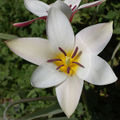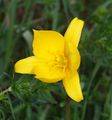Tulip
| Tulip |
|---|

|
| Scientific Classification |
|
| Species |
|
| Colorful Tulips |
Tulips are any of the species of flowing plants belonging to the taxonomic genus Tulipa. The tulip is also known as Ocean lotus, dry lotus and musk grass. Because the growth area latitudes are different, the flowering times vary. It's generally in late March to early May. It usually has 3-5 floral leaves. The flowers are large and bright, and petals are red or mixed with white and yellow, sometimes white or yellow. They are 5-7 cm long, 2-4 cm wide, have six stamens and have hairless filaments.[3] Tulip is the national flower of Turkey, Kazakhstan and the Netherlands.It origins in the Middle East. Later, tulip is called "the world of flowers", and it becomes a representative of fashion and a cosmopolitan symbol.[4]
The tulip plants also have a high value of medical uses. During the second world war, the Dutch overcame the scarcity of food by eating the bulbs of tulips.[5]
Body Design
The tulip is able to grow between 4 inches and 8 inches. It is typically a perennial herb with sepia scarf skin and has a bulb egg form. The diameter of the tulip is usually about 2cm, and it grows from bulbs. The bulbs have a yellowish fibrous outer coating.[6] The tulip's leaf is strap-shaped, with a waxy coating. The tulip has two to six leaves. Some species can have up to 12. [7] People usually can find the leaves growing on the stem. The leaves are elliptic-lanceolate or ovate-lanceolate. Each leave is 10-21 CM long and 1-0.6 CM in width.[8]
There are different shapes of tulip. They are cup-shaped, bowl-shaped, egg-shaped, ball-shaped, bell-shaped, funnel-shaped, lily-shaped, etc. The color of the petals are splendid and gorgeous. Humans focus on the improvement of genetic changes and hybrid cultivars, so now there are different colors of tulip petals. The colors are usually white, pink, magenta, purple, brown, yellow, orange and various shades’ of color or complex color.[9] The stem bases are often dark purple.The flowers solitary erects, 5-7.5 cm long; has 6 perigones, usually are obovate and the colors are bright yellow or purple, with yellow stripes and spots.[3] [10]
Life Cycle
The dormant Period of tulip is December to March. Tulip bulbs need to be warm and dry to prevent disease and promote flowering. As a rule of thumb, they need eight weeks of warmth (18-28 degrees). [11] In April, tulips need cooling. Only in areas without winter frosts is it necessary to keep tulips not frozen. Six weeks should do it and areas with winter frosts will give the bulb the cooling they need. During April and May, tulips need well drained soil and prefer full sun to part shade. [12] Tulips like a slightly acidic soil (pH 6-7). The existing energy in the bulb produces the new growth. [13]
Between July and November, is the time period for tulip's growing. When the tips are coming through the ground they will benefit from a dose of high nitrogen fertilizer. The new bulbs will grow mainly after flowering. [14]The last period is harvest. It is from November to December. The bulb that was planted has gone and new ones have grown. [15]
Ecology
Tulip is used from central Asia. The tulip goes to Europe in 1500s. [16] The Tulip plant is native to Asia, southern Europe and Africa. It requires adapted circumstances to grow regularly. It needs to grow in a cold winter.[17] Because the growth area latitude is different, flowering varies. Almost all of the countries can grow tulips in the ground. So far, people keep hybrid cultivars and natural tulips in or outside of rooms to plant them. [18] [19]
Tulip is a steppe and winter-rain Mediterranean vegetation. Tulipa is also a long-day flower, likes the sunny, sheltered or warm and humid areas in winter. It has normal growth when the temperature is more than 8 ℃, and it can be resistant to -14 ℃. [20]The tulip's cold resistance is strong. If thick snow covers in cold regions, the tulips's bulbs are able to overwintering. But it fears the intense heat of summer. If the summer comes early and it's really hot, the bulbs will start dormancy. The tulip has requirements about humus-rich, loose and fertile, well-drained slightly acidic sandy loam, avoiding alkali soil. [3]
Uses
The tulip as a number of medicinal uses.[21] The Tulip's pharmacological effects are found in its flowers and leaves which contain a toxic alkaloid, with physiological effects similar to Veratrine. The tuliposide ABC inhibits the bacteria bacillus subtilis. [22]Tulips sap through cation and anion exchange resin of, it still reacts the antibacterial effect of Staphylococcus aureus. Alcohol extract the stem and leaves of Bacillus cereus mycoides have an antibacterial effect, its active ingredient contains a variety of amino acids. [23] The Cherokee Indians uses the leaves to make an ointment to apply for inflammation. Leaves can be regarded as a poultice. [24]
Also, people use tulip to produce Tulip blush, Tulip Poultice, Tulip Cream,etc. to improve human's quality of life. For the tulip blush, its supplement works by the extract from the petals, helping in removal of spots and blemishes from the skin. The tulip cream helps with itches and skin irritation. Now it is used by Dutch' workers a lot. The tulip poultice make of the crushed petals, and is used for areas where there is skin rash, bee stings or insect bites. By using tulip poultice, it helps to find quick relief from the irritation. In addiion, the petals of tulips also are able to heal burns and rashes on the skin. It usually gives a soothing effect.[25]
Video
This video is showing us the tulips' life and death
Gallery
Tulip
(Tulipa vvedenskyi) [26]
References
- ↑ Tulipa L. USDA. Web.14 May 2015,23:38.Unknown Author.
- ↑ Tulipa WIKISPECIES. Web.11 June 2014.Unknown Author.
- ↑ 3.0 3.1 3.2 Tulip Wikipedia. Web. 15 May 2015.Unknown Author.
- ↑ Tulip Baidu. Web. 27 May 2015. Author Unknown.
- ↑ Tulip: Third Most Popular Garden Flower Medicinal Plants. Web. 27 May 2015. Author Unknown.
- ↑ 1904 autumn catalog of bulbs, seeds, plants BHL. Web. 18 March 2015.Unknown Author.
- ↑ Tulipa L., Sp. Pl.: 305 (1753). Kew. Web. September 25 2014. Unknown Author.
- ↑ Tulip Wikipeida. Web. 15 May 2015. Unknown Author.
- ↑ tulip '"The Free Dictionary. Web. 18 May 2015. Unknown Author.
- ↑ St. Lawrence Lewis. Part Two of the Life Cycle of a Tulip '"NYLearns. Web. 27 May 2015.
- ↑ Life Cycle Of A Tulip 'Life cycle of tulips. Web. 26 May 2015.Unknown Author.
- ↑ Life Cycle Of A Tulip 'Rocketswag. Web. 26 May 2015. Unknown Author.
- ↑ Jonathon Berlin and Phil Geib The fleeting bloom of the tulip 'Chicigo. Web. 26 May 2015.
- ↑ The Life Cycle of Tulips 'Buzzle. Web. 26 May 2015.Unknown Author.
- ↑ The Life Cycle of Tulips 'Life cycle of tulips. Web. 26 May 2015.Unknown Author.
- ↑ HISTORY OF DAFFODILS AND TULIPS 'American Meadows. Web. 27 May 2015.Unknown Author.
- ↑ Tulip 'The Poison Plant Patch. Web. 25 May 2015.Unknown Author.
- ↑ Easter weekend outing 'examiner. Web. 6 April 2012.Unknown Author.
- ↑ DISTRIBUTION AND OCCURRENCE 'Index of Species Information. Web. 26 May 2015.Unknown Author.
- ↑ The Importance of Ecology 'Freeman Wong. Web. 26 May 2015.Unknown Author.
- ↑ Tulip: Third Most Popular Garden Flower Medicinal Plants. Web. 27 May 2015. Author Unknown.
- ↑ Benjamin ShorterThe Uses of the Tulip Flower EHow. Web. 27 May 2015.
- ↑ Tulip Baidu. Web. 27 May 2015. Author Unknown.
- ↑ Tulip Sieera. Web. 27 May 2015. Author Unknown.
- ↑ Tulip Medicinal Plants. Web. 27 May 2015. Author Unknown.
- ↑ Tulipa Wikimedia Commons. Web. 22 December 2014, at 19:59 .Unknown Author.




























